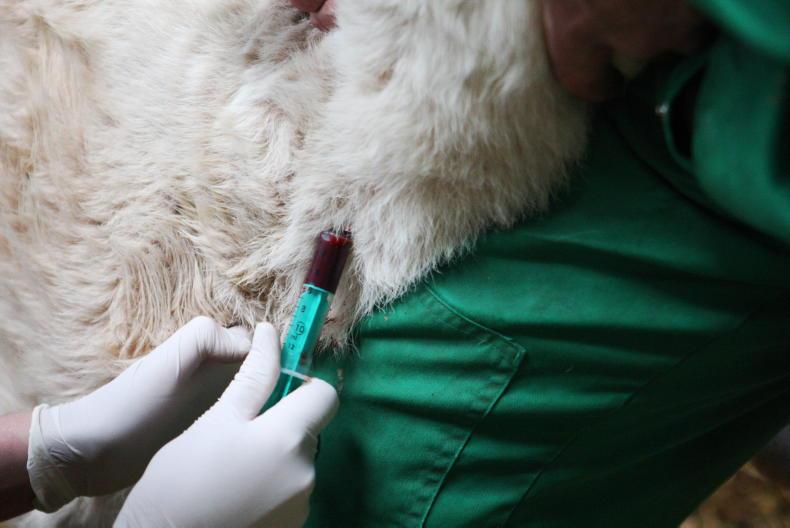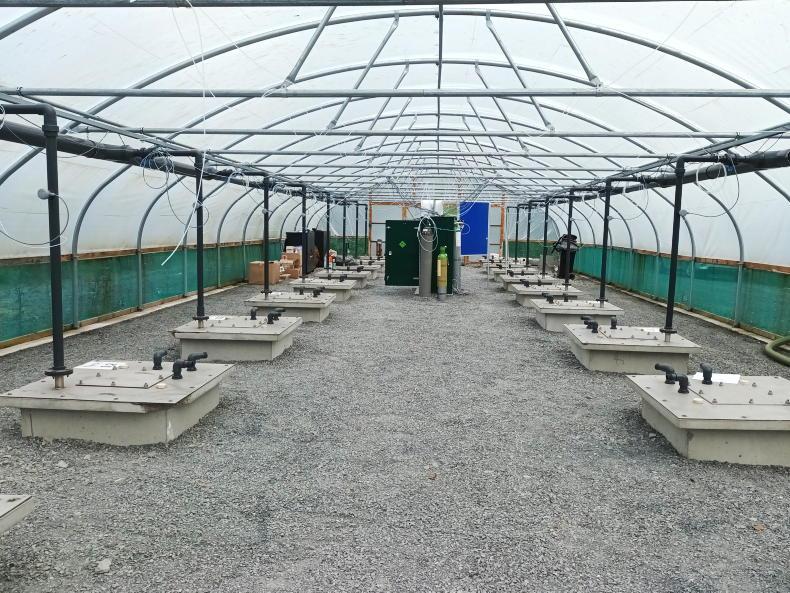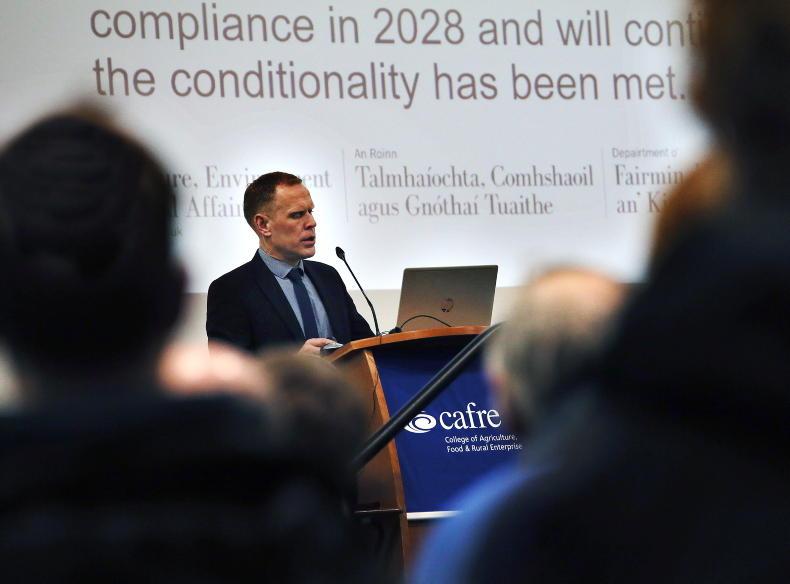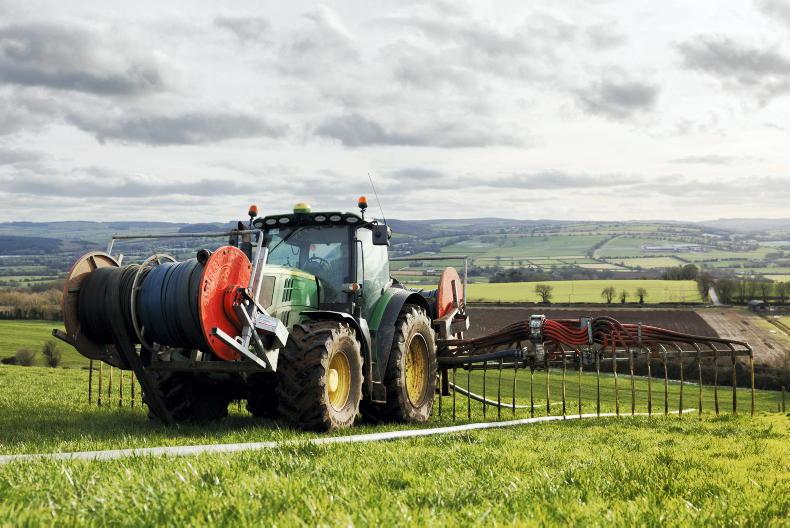Grazed grass remains the most cost-effective feed on cattle and sheep farms this year, and cutting fertiliser application rates to control input costs will be a false economy, farmers attending webinars organised by AgriSearch, CAFRE and AFBI have been told.
Taking place over two nights, with an event for dairy farmers and a separate one for those with beef and sheep, both webinars heard from AFBI scientist Dr Debbie McConnell.
She highlighted how fertiliser typically accounts for 25% of the cost of producing 1kg of grazed grass. However, with slurry contributing more nutrients in a silage system, fertiliser accounts for 12% and 18% of the costs for two – and three-cut systems respectively.
As a result, the price hikes in fertiliser are likely to have a big impact on costs across the grazing platform.
McConnell presented data for a typical 40ha grazing area, using around 30t of fertiliser per annum. Moving from a cost for CAN of £300/t up to £600/t means additional expenditure of £8,940 is incurred.
Full cost analysis by AFBI, which includes CAN at £600/t, puts the cost of each tonne of grazed grass dry matter at £106/t
The same fertiliser price increase on a 40ha silage area will add £5,161 to costs when taking two cuts, and £7,868 when taking three cuts.
While the costs of grazed grass are up more than the costs of making silage, grazed grass remains the cheapest feed overall.
Full cost analysis by AFBI, which includes CAN at £600/t, puts the cost of each tonne of grazed grass dry matter (DM) at £106/t, compared to £157/t and £186/t of DM in a two- and three-cut system respectively.
Feed value ratio
Across the last 10 years of the GrassCheck programme in NI, each kg of Nitrogen (N) applied has on average grown 20kg of grass DM.
In addition, research work has shown that where an average of 150kg N/ha is applied across the season, the typical response is 26kg of grass DM per kg of N.
In all scenarios, right out to a fertiliser cost of nearly £1,000/t, it was still more economical to apply fertiliser and grow the grass
In her presentation, McConnell looked at how this response from each kg of N compares to the alternative of buying in extra concentrate feed.
In other words, farmers could reduce fertiliser input, grow less grass, and fill the energy deficit by feeding more meal.
In all scenarios, right out to a fertiliser cost of nearly £1,000/t, it was still more economical to apply fertiliser and grow the grass, rather than buy in the energy by way of concentrate.
Well-managed
At a CAN price of £300/t, the feed value of grass is around five times greater than the cost of fertiliser. At £600/t this does fall to around 2.5 times greater.
It is also important to point out that the AFBI figures are based on a farmer operating a well-managed grazing system and having swards that respond well to N. “To maximise that N response, we need good soil health, we need to get the timing of fertiliser application right, and we need to optimise our grass utilisation as well,” said McConnell.
March application
She highlighted that applying fertiliser in March is often marginal, and on average across GrassCheck farms, each 1kg of N applied in that month only grows 4kg of grass DM. That growth does not cover current costs, although she acknowledged that responses can vary significantly between years. Low N responses are also seen during periods of drought.
Estimate
When asked about the impact of a dairy farmer deciding to reduce fertiliser application from 250kg N/ha to 150kg N/ha across a 40ha grazing block this year, she estimated that the saving in fertiliser costs would be around £9,000. But reducing N by 100kg is likely to mean 2t less DM/ha is grown. To fill the resultant feed gap with concentrate (and therefore maintain stocking rate) would cost up to £20,000.
Make
the best use of
nutrients
Given current fertiliser prices, soil analysis and fertiliser planning have never been more important, emphasised CAFRE’s Aveen McMullan.
With over 60% of soils tested in NI below a target pH of at least 6, the starting point on farms should be to correct this. Soil testing kits are available from DAERA Direct offices.
Where soils have a pH between 5 and 5.5, they will only utilise around 77% of the N applied, which means that when CAN costs £600/t, there is a potential loss of £106 for every tonne spread. In soils between pH 6 and 6.5, there is 100% utilisation of all nitrogen, phosphorous and potash.
They are feeding off the nutrients in the soil and will ultimately reduce grass yield
Soil structure is also important as it can impede grass growth, and there is little point applying nutrients to a field full of weeds.
“They are feeding off the nutrients in the soil and will ultimately reduce grass yield,” McMullan maintained.
Slurry
With high fertiliser prices, slurry is also taking on a new value, and should not be seen as a waste product.
Typical cattle slurry at 6% dry matter (DM) supplies nine units of N, five units of P and 20 units of K for every 1,000 gallons/acre applied using low-emission slurry spreading equipment (LESSE) in the spring.
“Applying slurry in spring will result in better utilisation. Aim to hit grass at the start of the season, when growth starts,” said McMullan.
Farmers using a splash plate in February must keep 15m from watercourses, which reverts to 10m from March onwards
“Don’t apply when rain is forecast in the next few days. There is little point in applying nutrients where there is a risk they could be washed into waterways.”
She also emphasised the importance of keeping within all the rules. Chemical phosphorus (P) or high-P manures can only be applied when there is a crop need (identified by a soil analysis), while farmers spreading slurry in February are limited to a maximum of 2,700 gallons per acre.
Farmers using a splash plate in February must keep 15m from watercourses, which reverts to 10m from March onwards.
For those with LESSE the buffer is 5m in February, which moves to 3m in March.
To create a fertilisation plan across the farm, a CAFRE nutrient calculator is available via DAERA online services.
First-cut silage gives the best response to nitrogen
While farmers might be tempted to reduce fertiliser inputs for first-cut silage in the hope of a price drop later in the year, it is this first cut that delivers the best response to nitrogen (N), said CAFRE dairy technologist Robert Patterson.
During his presentation, he cautioned against an over-reliance on later cuts of silage to meet a potential deficit in the first cut because less fertiliser is used.
“This is a very risky strategy. I would want to be going into the later summer period on the best foot forward, knowing that I had a good supply of first-cut silage in the bank,” he said.
Where soils are at optimum fertility, with pH of 6.2 and Index 2+ for phosphorus (P) and potassium (K), he outlined how 2,500 gallons/acre of slurry spread using LESSE will come close to meeting P and K needs.
There is still a deficit of 91kg/ha (73 units/acre) of nitrogen which would be met with 2.7 bags/acre of CAN. Splitting the fertiliser application over two dressings will increase nitrogen utilisation and decrease the risk of nutrient loss.
Yields
If N is undersupplied, this has the potential to hit yields, and also potentially silage quality, and in particular crude protein levels.
Patterson also encouraged farmers to include sulphur, especially in early and mid-season applications. He maintained that it has not risen in cost similar to N, and will add around £10/t – £15/t to prices. “It would be unwise to spend so much money on N, to have grass growth limited by sulphur,” he said.
Applying fertiliser to take advantage of peak growth
Peak grass growth normally occurs in May and June, and on many beef and sheep farms, it is often a time when farmers ease off on fertiliser inputs to stop grass getting ahead of stock.
However, it might be necessary to think differently this year, suggested CAFRE beef and sheep adviser Rachel Megarrell.
“When the grass plant is actively growing, perhaps that is the time to put extra N on. Take out the higher covers for silage as bales,” she said.
But as well as ensuring fertiliser is applied during optimal times of growth, she said that many beef and sheep farmers can significantly improve grass utilisation by moving away from set stocking, to rotational or paddock grazing.
“It is amazing the benefit we see from just splitting a field in two,” she said.
The ideal is to graze a paddock in three days, and then let it rest for three weeks.
Megarrell also encouraged farmers to ensure they remove passengers (such as barren cows), have a plan for livestock sales if using less fertiliser, and not to forget about the importance of silage quality, especially if feeding autumn-calving cows or finishing cattle.
She also reminded farmers that where land has been reseeded in recent years, cutting back on inputs will have a negative impact on the life of the sward.
“If you have gone to the expense of reseeding, you want to protect your investment as much as possible,” Megarrell said.
Read more
Yara to build hydrogen plant and produce fossil-free fertiliser
Lime spreading costs on the rise
Grazed grass remains the most cost-effective feed on cattle and sheep farms this year, and cutting fertiliser application rates to control input costs will be a false economy, farmers attending webinars organised by AgriSearch, CAFRE and AFBI have been told.
Taking place over two nights, with an event for dairy farmers and a separate one for those with beef and sheep, both webinars heard from AFBI scientist Dr Debbie McConnell.
She highlighted how fertiliser typically accounts for 25% of the cost of producing 1kg of grazed grass. However, with slurry contributing more nutrients in a silage system, fertiliser accounts for 12% and 18% of the costs for two – and three-cut systems respectively.
As a result, the price hikes in fertiliser are likely to have a big impact on costs across the grazing platform.
McConnell presented data for a typical 40ha grazing area, using around 30t of fertiliser per annum. Moving from a cost for CAN of £300/t up to £600/t means additional expenditure of £8,940 is incurred.
Full cost analysis by AFBI, which includes CAN at £600/t, puts the cost of each tonne of grazed grass dry matter at £106/t
The same fertiliser price increase on a 40ha silage area will add £5,161 to costs when taking two cuts, and £7,868 when taking three cuts.
While the costs of grazed grass are up more than the costs of making silage, grazed grass remains the cheapest feed overall.
Full cost analysis by AFBI, which includes CAN at £600/t, puts the cost of each tonne of grazed grass dry matter (DM) at £106/t, compared to £157/t and £186/t of DM in a two- and three-cut system respectively.
Feed value ratio
Across the last 10 years of the GrassCheck programme in NI, each kg of Nitrogen (N) applied has on average grown 20kg of grass DM.
In addition, research work has shown that where an average of 150kg N/ha is applied across the season, the typical response is 26kg of grass DM per kg of N.
In all scenarios, right out to a fertiliser cost of nearly £1,000/t, it was still more economical to apply fertiliser and grow the grass
In her presentation, McConnell looked at how this response from each kg of N compares to the alternative of buying in extra concentrate feed.
In other words, farmers could reduce fertiliser input, grow less grass, and fill the energy deficit by feeding more meal.
In all scenarios, right out to a fertiliser cost of nearly £1,000/t, it was still more economical to apply fertiliser and grow the grass, rather than buy in the energy by way of concentrate.
Well-managed
At a CAN price of £300/t, the feed value of grass is around five times greater than the cost of fertiliser. At £600/t this does fall to around 2.5 times greater.
It is also important to point out that the AFBI figures are based on a farmer operating a well-managed grazing system and having swards that respond well to N. “To maximise that N response, we need good soil health, we need to get the timing of fertiliser application right, and we need to optimise our grass utilisation as well,” said McConnell.
March application
She highlighted that applying fertiliser in March is often marginal, and on average across GrassCheck farms, each 1kg of N applied in that month only grows 4kg of grass DM. That growth does not cover current costs, although she acknowledged that responses can vary significantly between years. Low N responses are also seen during periods of drought.
Estimate
When asked about the impact of a dairy farmer deciding to reduce fertiliser application from 250kg N/ha to 150kg N/ha across a 40ha grazing block this year, she estimated that the saving in fertiliser costs would be around £9,000. But reducing N by 100kg is likely to mean 2t less DM/ha is grown. To fill the resultant feed gap with concentrate (and therefore maintain stocking rate) would cost up to £20,000.
Make
the best use of
nutrients
Given current fertiliser prices, soil analysis and fertiliser planning have never been more important, emphasised CAFRE’s Aveen McMullan.
With over 60% of soils tested in NI below a target pH of at least 6, the starting point on farms should be to correct this. Soil testing kits are available from DAERA Direct offices.
Where soils have a pH between 5 and 5.5, they will only utilise around 77% of the N applied, which means that when CAN costs £600/t, there is a potential loss of £106 for every tonne spread. In soils between pH 6 and 6.5, there is 100% utilisation of all nitrogen, phosphorous and potash.
They are feeding off the nutrients in the soil and will ultimately reduce grass yield
Soil structure is also important as it can impede grass growth, and there is little point applying nutrients to a field full of weeds.
“They are feeding off the nutrients in the soil and will ultimately reduce grass yield,” McMullan maintained.
Slurry
With high fertiliser prices, slurry is also taking on a new value, and should not be seen as a waste product.
Typical cattle slurry at 6% dry matter (DM) supplies nine units of N, five units of P and 20 units of K for every 1,000 gallons/acre applied using low-emission slurry spreading equipment (LESSE) in the spring.
“Applying slurry in spring will result in better utilisation. Aim to hit grass at the start of the season, when growth starts,” said McMullan.
Farmers using a splash plate in February must keep 15m from watercourses, which reverts to 10m from March onwards
“Don’t apply when rain is forecast in the next few days. There is little point in applying nutrients where there is a risk they could be washed into waterways.”
She also emphasised the importance of keeping within all the rules. Chemical phosphorus (P) or high-P manures can only be applied when there is a crop need (identified by a soil analysis), while farmers spreading slurry in February are limited to a maximum of 2,700 gallons per acre.
Farmers using a splash plate in February must keep 15m from watercourses, which reverts to 10m from March onwards.
For those with LESSE the buffer is 5m in February, which moves to 3m in March.
To create a fertilisation plan across the farm, a CAFRE nutrient calculator is available via DAERA online services.
First-cut silage gives the best response to nitrogen
While farmers might be tempted to reduce fertiliser inputs for first-cut silage in the hope of a price drop later in the year, it is this first cut that delivers the best response to nitrogen (N), said CAFRE dairy technologist Robert Patterson.
During his presentation, he cautioned against an over-reliance on later cuts of silage to meet a potential deficit in the first cut because less fertiliser is used.
“This is a very risky strategy. I would want to be going into the later summer period on the best foot forward, knowing that I had a good supply of first-cut silage in the bank,” he said.
Where soils are at optimum fertility, with pH of 6.2 and Index 2+ for phosphorus (P) and potassium (K), he outlined how 2,500 gallons/acre of slurry spread using LESSE will come close to meeting P and K needs.
There is still a deficit of 91kg/ha (73 units/acre) of nitrogen which would be met with 2.7 bags/acre of CAN. Splitting the fertiliser application over two dressings will increase nitrogen utilisation and decrease the risk of nutrient loss.
Yields
If N is undersupplied, this has the potential to hit yields, and also potentially silage quality, and in particular crude protein levels.
Patterson also encouraged farmers to include sulphur, especially in early and mid-season applications. He maintained that it has not risen in cost similar to N, and will add around £10/t – £15/t to prices. “It would be unwise to spend so much money on N, to have grass growth limited by sulphur,” he said.
Applying fertiliser to take advantage of peak growth
Peak grass growth normally occurs in May and June, and on many beef and sheep farms, it is often a time when farmers ease off on fertiliser inputs to stop grass getting ahead of stock.
However, it might be necessary to think differently this year, suggested CAFRE beef and sheep adviser Rachel Megarrell.
“When the grass plant is actively growing, perhaps that is the time to put extra N on. Take out the higher covers for silage as bales,” she said.
But as well as ensuring fertiliser is applied during optimal times of growth, she said that many beef and sheep farmers can significantly improve grass utilisation by moving away from set stocking, to rotational or paddock grazing.
“It is amazing the benefit we see from just splitting a field in two,” she said.
The ideal is to graze a paddock in three days, and then let it rest for three weeks.
Megarrell also encouraged farmers to ensure they remove passengers (such as barren cows), have a plan for livestock sales if using less fertiliser, and not to forget about the importance of silage quality, especially if feeding autumn-calving cows or finishing cattle.
She also reminded farmers that where land has been reseeded in recent years, cutting back on inputs will have a negative impact on the life of the sward.
“If you have gone to the expense of reseeding, you want to protect your investment as much as possible,” Megarrell said.
Read more
Yara to build hydrogen plant and produce fossil-free fertiliser
Lime spreading costs on the rise









SHARING OPTIONS